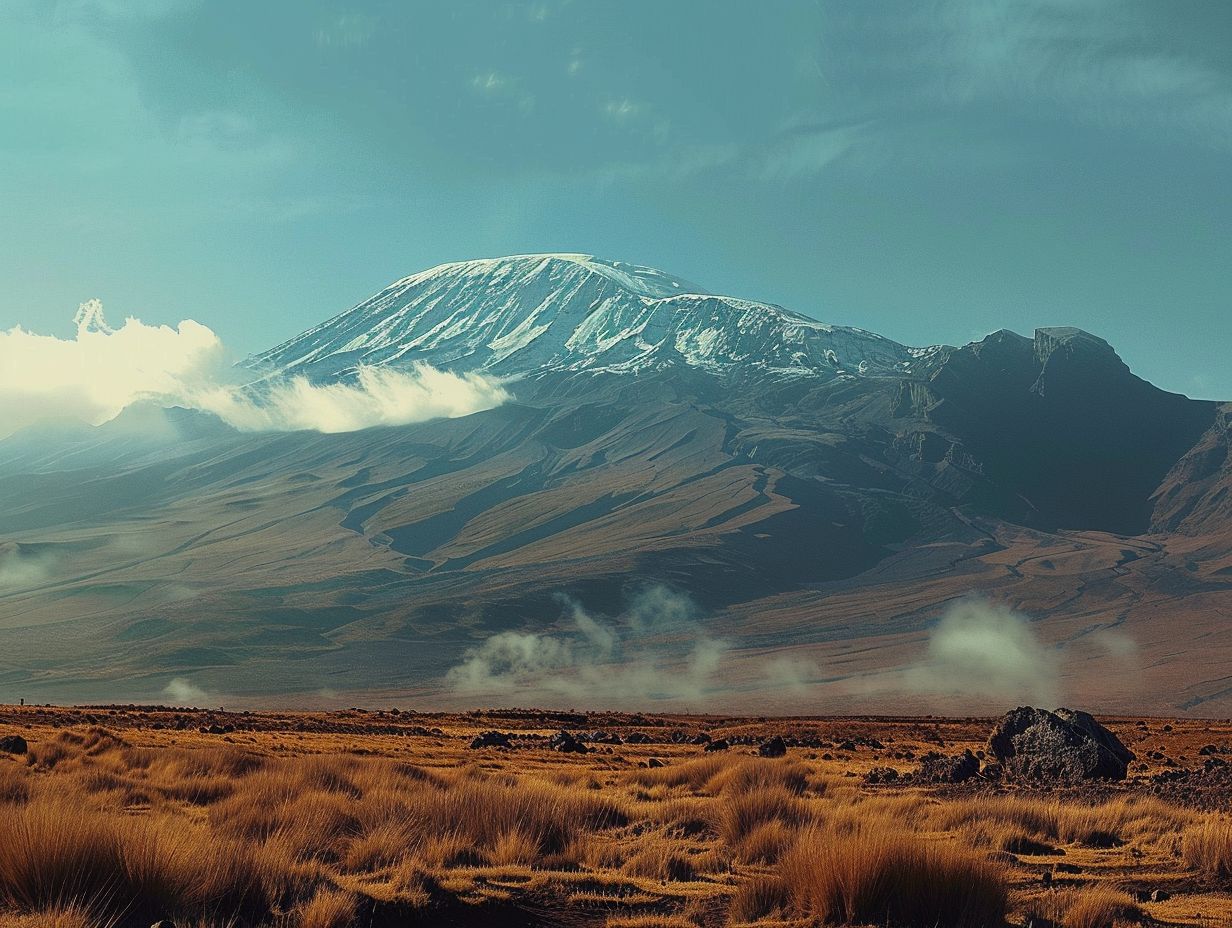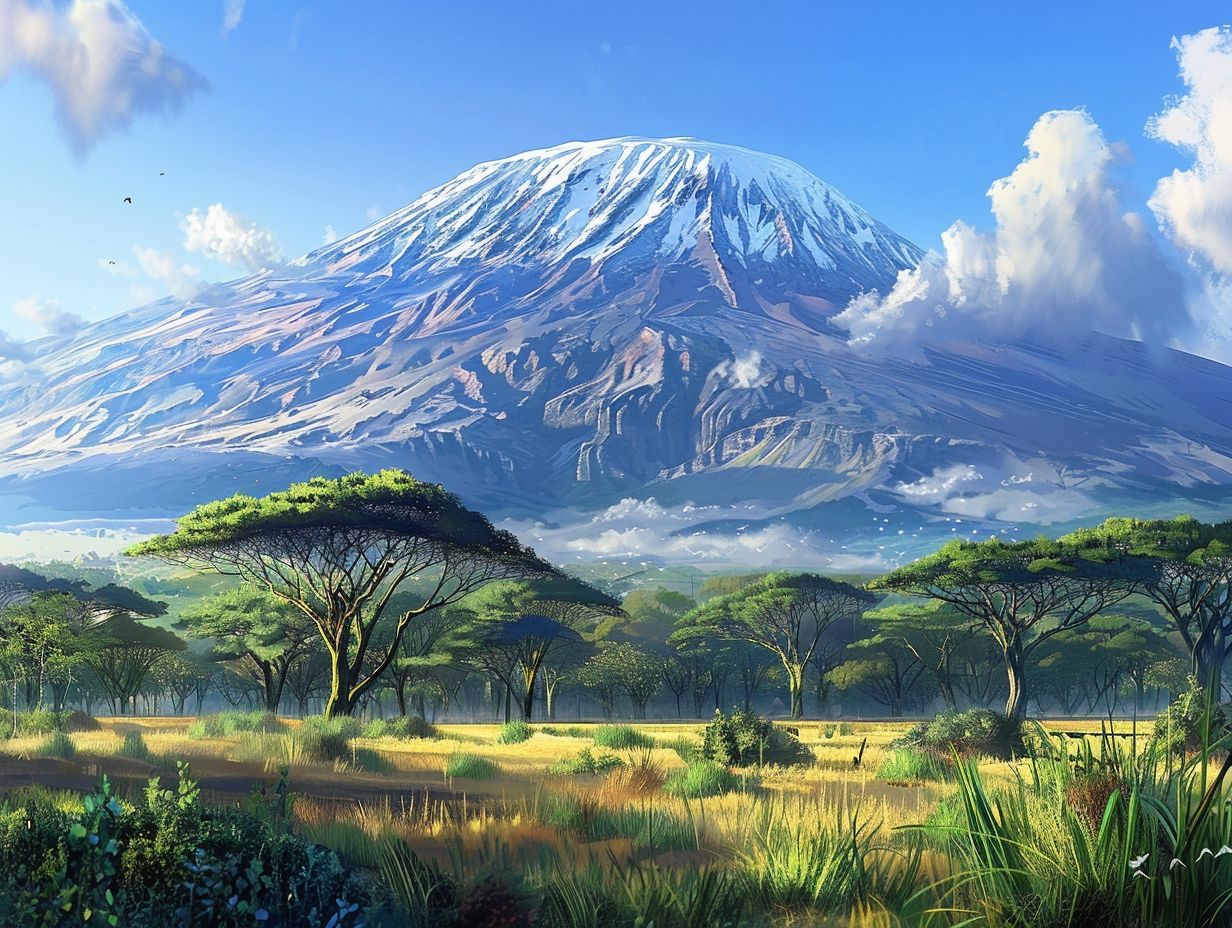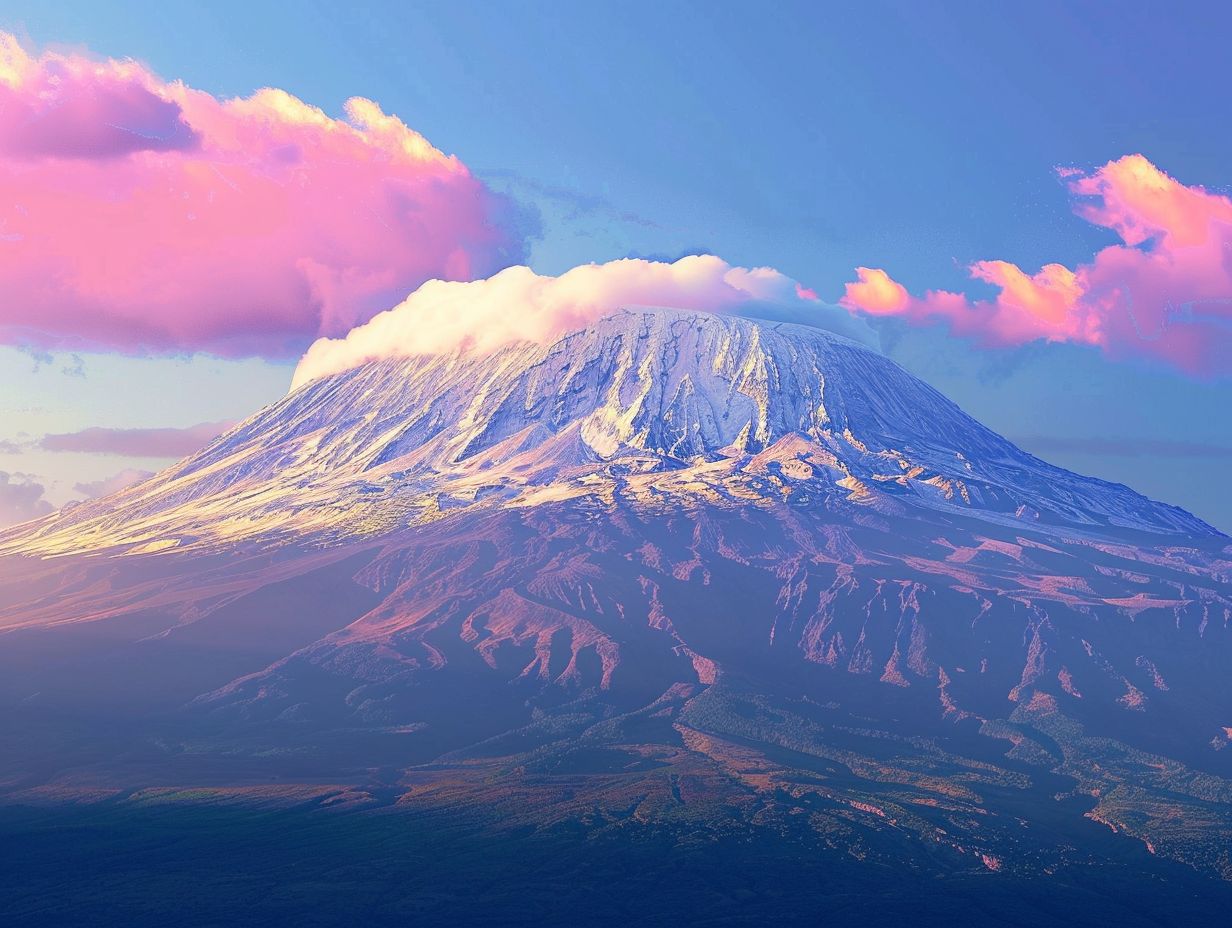
Have you ever wondered why Mount Kilimanjaro, the tallest peak in Africa, is capped with snow and ice?
Discover the fascinating factors that contribute to its unique climate and altitude. Learn about the effects of global warming on its glaciers and the implications for local communities and biodiversity.
Explore the importance of preserving this natural wonder and join the discussion on conservation efforts and sustainable tourism practices aimed at protecting Mount Kilimanjaro for future generations.
Key Takeaways:

- Mount Kilimanjaro’s location on the equator and its high altitude contribute to the presence of snow and ice on its peak.
- The melting of snow and ice on Mount Kilimanjaro has negative implications for local communities and biodiversity.
- Conservation efforts and sustainable tourism are crucial in preserving Mount Kilimanjaro’s snow and ice for future generations.
Why Does Mount Kilimanjaro Have Snow and Ice?
Mount Kilimanjaro’s snow and ice are attributed to its glaciers and the presence of an ice cap that has been historically maintained despite the effects of global warming.
What is the Altitude of Mount Kilimanjaro?
Mount Kilimanjaro’s summit, Uhuru Point, stands at an elevation of 5,895 meters (19,341 feet) above sea level, making it the highest point in Africa.
At this impressive height, the peak of Mount Kilimanjaro offers a breathtaking view that extends over vast expanses of the African landscape. The elevation of Uhuru Point not only makes it a remarkable geographical feature but also significantly influences the climate and vegetation found on the mountain.
Scientists from Ohio State University have conducted expeditions to study the impact of this altitude, showcasing how the mountain’s varying altitudinal zones create diverse ecological niches. As one ascends towards the summit, the environmental conditions change drastically, leading to unique flora and fauna adaptations at different elevations.
How Does Altitude Affect Temperature?

The temperature on Mount Kilimanjaro decreases with altitude, following a pattern of cooler conditions at higher elevations due to the mountain’s altitude gradient.
As climbers ascend Kilimanjaro, they experience a drop in temperature averaging about 3.5°F for every 1,000 feet gained. This phenomenon is known as the lapse rate, a significant factor in the climate variations observed on the mountain.
The changes in temperature are crucial for the diverse ecosystems found on Kilimanjaro, from the lush rainforest at its base to the arid alpine desert near the summit. Scientists have studied these temperature shifts extensively to understand the impacts of global climate change on such sensitive environments.
What is the Effect of Global Warming on Mount Kilimanjaro’s Snow and Ice?
Global warming has led to accelerated glacier melting on Mount Kilimanjaro, causing a significant reduction in snow and ice cover over the years.
The consequences of this phenomenon are far-reaching, with the once pristine white cap of Kilimanjaro gradually diminishing. Scientists like Lonnie Thompson have highlighted how this loss of ice and snow on the mountain not only alters its physical appearance but also disrupts ecosystems and water sources.
Greenpeace reports indicate that the melting glaciers have downstream impacts, affecting water availability and biodiversity in the region.
What is the Glacial History of Mount Kilimanjaro?
The glacial history of Mount Kilimanjaro dates back thousands of years, with evidence of extensive ice cover during different climatic periods.
Early research conducted by Johannes Rebmann in the 19th century sheds light on the once-vast ice formations that adorned Kilimanjaro’s peaks. Over time, geological forces and changing climate patterns have played critical roles in shaping the mountain’s glacial history.
Studies indicate that the glaciers on Kilimanjaro have undergone significant fluctuations in size and extent, with visible retreats observed over the past century.
The mountain’s glaciers serve as a valuable record of environmental change, reflecting the impact of human activities and global warming on the delicate ice formations. Modern expeditions continue to monitor and analyze these glaciers to better understand the dynamics of glacial retreat and to assess the mountain’s long-term sustainability.
What are the Implications of Melting Snow and Ice on Mount Kilimanjaro?
The melting snow and ice on Mount Kilimanjaro have far-reaching implications, affecting local communities, biodiversity, and the broader environmental landscape.
Impact on Local Communities
The melting snow and ice on Mount Kilimanjaro directly impact local communities, such as the Chagga tribe, by altering water sources and agricultural patterns.
As the snow and ice on the majestic mountain continue to diminish, the once reliable water sources for the Chagga people are dwindling. This has led to significant challenges in irrigation for agriculture, affecting crop yields and livelihoods of the community.
The changing landscape has forced the Chagga tribe to adapt to new farming techniques and explore alternative ways to secure water for their crops. It’s fascinating to witness how this community is resilient in facing environmental shifts, showcasing their deep connection with the land.
Threat to Biodiversity

The diminishing snow and ice on Mount Kilimanjaro pose a significant threat to the biodiversity of the region, impacting unique ecosystems and species adaptation.
As the glaciers recede, crucial water sources for plants and animals are at risk, leading to habitat disruptions that can have cascading effects on the entire local ecosystem.
Studies have shown that the reduced ice cover directly affects the distribution and abundance of various species, pushing many to the brink of extinction. The retreat of ice may also expose fragile plants to harsh sunlight, altering their growth patterns and potentially leading to decline.
Along with these direct impacts, the changes in climate patterns due to melting snow and ice can trigger shifts in vegetation zones, influencing the delicate balance of the region’s biodiversity. Conservation efforts are essential to safeguard the endangered species that call Kilimanjaro home and preserve the unique ecological heritage for future generations.
What are the Implications of Melting Snow and Ice on Mount Kilimanjaro?
Melting snow and ice on Mount Kilimanjaro have significant environmental and societal implications, affecting local communities, biodiversity, and water resources.
Impact on Local Communities
The melting snow and ice on Mount Kilimanjaro have direct consequences for local communities, affecting water sources, agricultural practices, and the delicate ecosystem of the region.
As climate change intensifies, the accelerated melting of the glaciers on Kilimanjaro has led to a significant decrease in water availability for nearby villages and towns.
This has forced communities to travel longer distances to fetch water, putting added strain on already limited resources. The altered water flow patterns due to melting snow have disrupted traditional agricultural schedules, making it difficult for farmers to predict planting and harvesting cycles.
The cascading effects extend to the local flora and fauna, with shifts in temperature and moisture levels impacting the diverse ecosystem surrounding the mountain. Environmental experts have noted changes in vegetation, wildlife behavior, and water quality, all linked to the melting ice on Kilimanjaro.
Threat to Biodiversity
The loss of snow and ice on Mount Kilimanjaro poses a severe threat to the biodiversity and delicate ecosystem of the region, endangering unique species and habitats.
As the glaciers recede and the snow cover diminishes due to climate change, the consequences are far-reaching. The disappearance of these frozen masses can lead to alterations in local weather patterns, affecting vegetation growth and water availability.
This disruption can result in habitat loss for various plant and animal species adapted to the alpine environment. The melting snow and ice can contribute to water scarcity issues downstream, impacting both human communities and wildlife.
A study published in the International Journal of Climatology highlighted that the melting ice on Kilimanjaro has accelerated significantly in recent decades, raising concerns about the future of the mountain’s ecosystem.
The report indicated that this rapid ice loss not only threatens endemic species found nowhere else but also endangers fragile ecosystems that are vital for maintaining a balanced environment.
How is Mount Kilimanjaro Being Protected?
Mount Kilimanjaro is under protection through conservation efforts and sustainable tourism practices aimed at preserving the mountain’s natural beauty and ecological balance.
Conservation Efforts

Dedicated conservation efforts are actively working to protect the fragile ecosystem and natural beauty of Mount Kilimanjaro, emphasizing sustainable practices and environmental stewardship.
One of the key initiatives in maintaining Kilimanjaro’s ecological balance is through robust reforestation programs. These projects focus on planting native trees to combat deforestation and restore the natural habitat for wildlife.
Waste management strategies play a crucial role in preserving the mountain’s environment. Efforts are made to reduce, recycle, and properly dispose of waste to minimize the ecological impact.
Collaboration with local communities is also a significant aspect of these conservation endeavors, creating awareness, providing education, and engaging residents in sustainable practices to ensure long-term environmental preservation.
Frequently Asked Questions
Why Does Mount Kilimanjaro Have Snow And Ice?
Mount Kilimanjaro is a tropical mountain, so it might seem unusual for it to have snow and ice. However, there are several factors that contribute to this phenomenon.
What is the elevation of Mount Kilimanjaro?
Mount Kilimanjaro stands at 19,341 feet (5,895 meters) tall, making it the highest mountain in Africa and one of the tallest in the world.
How does altitude play a role in the presence of snow and ice on Mount Kilimanjaro?
The higher the elevation, the colder the air temperature becomes. This drop in temperature can cause water vapor to freeze and form snow and ice on the mountain’s peaks.
Is Mount Kilimanjaro the only mountain in Africa with snow and ice?
No, there are several other mountains in Africa with snow and ice, such as Mount Kenya and the Rwenzori Mountains. However, Mount Kilimanjaro is the most well-known and easily accessible.
Does the snow and ice on Mount Kilimanjaro ever melt?
Yes, the snow and ice on Mount Kilimanjaro do melt during the warmer months. However, due to its high elevation, the mountain remains snowy and icy year-round.
How has climate change affected the snow and ice on Mount Kilimanjaro?
Unfortunately, due to global warming, Mount Kilimanjaro’s snow and ice have been steadily decreasing over the years. Scientists predict that the mountain may be completely ice-free in the near future.